Health Risk Assessment of Heavy Metals in Shallow Groundwater of Coal–Poultry Farming Districts
Abstract
:1. Introduction
2. Materials and Methods
2.1. Site Description
2.2. Collection and Analysis of Water Samples
2.3. PMF
2.4. Health Risk Assessment
2.5. Non-Carcinogenic Risk Assessment
2.6. Carcinogenic Risk Assessment
3. Results and Discussion
3.1. Distributions of Heavy Metals
3.2. Source Analysis
3.3. Human Health Risk Assessment
3.4. Health Risk Assessment of Heavy Metals from Different Sources
3.5. Uncertainty Analysis
4. Conclusions
Author Contributions
Funding
Institutional Review Board Statement
Data Availability Statement
Acknowledgments
Conflicts of Interest
References
- Long, X.; Liu, F.; Zhou, X.; Pi, J.; Yin, W.; Li, F.; Huang, S. Estimation of spatial distribution and health risk by arsenic and heavy metals in shallow groundwater around Dongting Lake Plain using GIS mapping. Chemosphere 2020, 269, 128698. [Google Scholar] [CrossRef]
- Xiao, J.; Wang, L.; Chai, N.; Liu, T.; Jin, Z.; Rinklebe, J. Groundwater hydrochemistry, source identification and pollution assessment in intensive industrial areas, eastern Chinese Loess Plateau. Environ. Pollut. 2021, 278, 116930. [Google Scholar] [CrossRef] [PubMed]
- Luo, M.; Zhang, Y.; Li, H.; Hu, W.; Xiao, K.; Yu, S.; Zheng, C.; Wang, X. Pollution assessment and sources of dissolved heavy metals in coastal water of a highly urbanized coastal area: The role of groundwater discharge. Sci. Total Environ. 2022, 807, 151070. [Google Scholar] [CrossRef] [PubMed]
- Goyal, V.C.; Singh, O.; Singh, R.; Chhoden, K.; Malyan, S.K. Appraisal of heavy metal pollution in the water resources of Western Uttar Pradesh, India and associated risks. Environ. Adv. 2022, 8, 100230. [Google Scholar] [CrossRef]
- Crippen, T.L.; Crippen, C.L.; Byrd, L.A.; Esquivel, J.F.; Beier, R.C.; Yeater, K. Poultry litter and the environment: Physiochemical properties of litter and soil during successive flock rotations and after remote site deposition. Sci. Total Environ. 2016, 553, 650–661. [Google Scholar] [CrossRef] [PubMed]
- Jia, L.; Liu, H.; Kong, Q.; Li, M.; Wu, S.; Wu, H. Interactions of high-rate nitrate reduction and heavy metal mitigation in iron-carbon-based constructed wetlands for purifying contaminated groundwater. Water Res. 2019, 169, 115285. [Google Scholar] [CrossRef] [PubMed]
- Qiao, J.; Zhu, Y.; Jia, X.; Shao, M.; Niu, X.; Liu, J. Distributions of arsenic and other heavy metals, and health risk assessments for groundwater in the Guanzhong Plain region of China. Environ. Res. 2019, 181, 108957. [Google Scholar] [CrossRef]
- Wang, J.; Liu, G.; Liu, H.; Lam, P.K.S. Multivariate statistical evaluation of dissolved trace elements and a water quality assessment in the middle reaches of Huaihe River, Anhui, China. Sci. Total Environ. 2017, 583, 421–431. [Google Scholar] [CrossRef]
- Peng, S.; Zhang, H.; Song, D.; Chen, H.; Lin, X.; Wang, Y. Distribution of antibiotic, heavy metals and antibiotic resistance genes in livestock and poultry feces from different scale of farms in Ningxia, China. J. Hazard. Mater. 2022, 440, 129719. [Google Scholar] [CrossRef]
- Mazhar, S.H.; Li, X.; Rashid, A.; Su, J.M.; Xu, J.; Brejnrod, A.D.; Su, J.Q.; Wu, Y.; Zhu, Y.G.; Zhou, S.G.; et al. Co-selection of antibiotic resistance genes, and mobile genetic elements in the presence of heavy metals in poultry farm environments. Sci. Total Environ. 2021, 755, 142702. [Google Scholar] [CrossRef]
- Sorinolu, A.J.; Tyagi, N.; Kumar, A.; Munir, M. Antibiotic resistance development and human health risks during wastewater reuse and biosolids application in agriculture. Chemosphere 2021, 265, 129032. [Google Scholar] [CrossRef] [PubMed]
- Hu, Y.; Cheng, H.; Shu, T. Environmental and Human Health Challenges of Industrial Livestock and Poultry Farming in China and Their Mitigation. Environ. Int. 2017, 107, 111–130. [Google Scholar] [CrossRef] [PubMed]
- Oyewale, A.T.; Adesakin, T.A.; Aduwo, A.I. Environmental Impact of Heavy Metals from Poultry Waste Discharged into the Olosuru Stream, Ikire, Southwestern Nigeria. J. Health Pollut. 2019, 9, 190607. [Google Scholar] [CrossRef] [PubMed]
- Fallah, B.; Fallah, A.; Ng, K.T.W.; Salama, A. Effects of groundwater metal contaminant spatial distribution on overlaying kriged maps. Environ. Sci. Pollut. Res. 2019, 26, 22945–22957. [Google Scholar] [CrossRef] [PubMed]
- Ahmed, N.; Bodrud-Doza, M.; Towfiqul Islam, A.R.M.; Hossain, S.; Moniruzzaman, M.; Deb, N.; Bhuiyan, M.A.Q. Appraising spatial variations of As, Fe, Mn and NO3 contaminations associated health risks of drinking water from Surma basin, Bangladesh. Chemosphere 2018, 218, 726–740. [Google Scholar] [CrossRef]
- Yin, S.Q.; Wang, Z.; Zhu, Z.; Zou, X.K.; Wang, W.T. Using Kriging with a heterogeneous measurement error to improve the accuracy of extreme precipitation return level estimation. J. Hydrol. 2018, 562, 518–529. [Google Scholar] [CrossRef]
- Wu, H.; Xu, C.; Wang, J.; Xiang, Y.; Ren, M.; Qie, H.; Zhang, Y.; Yao, R.; Li, L.; Lin, A. Health risk assessment based on source identification of heavy metals: A case study of Beiyun River, China. Ecotoxicol. Environ. Saf. 2021, 213, 112046. [Google Scholar] [CrossRef]
- Xu, J.; Gui, H.; Fang, H.; Dai, H.; Guo, Y.; Chen, J.; Li, C.; Chen, C.; Wang, C. Quantitative Contributions of the Sources, Contamination and Ecological Risk of Heavy Metals in Soils from a Closed Coal Mine of Huaibei Coalfield, Eastern China. Pol. J. Environ. Stud. 2021, 30, 4299–4309. [Google Scholar] [CrossRef]
- Feng, X.; Feng, Y.; Chen, Y.; Cai, J.; Li, Q.; Chen, J. Source apportionment of PM 2.5 during haze episodes in Shanghai by the PMF model with PAHs. J. Clean. Prod. 2022, 330, 129850. [Google Scholar] [CrossRef]
- Park, J.; Kim, H.; Kim, Y.; Heo, J.; Kim, S.W.; Jeon, K.; Yi, S.M.; Hopke, P.K. Source apportionment of PM2.5 in Seoul, South Korea and Beijing, China using dispersion normalized PMF. Sci. Total Environ. 2022, 833, 155056. [Google Scholar] [CrossRef]
- Magesh, N.S.; Tiwari, A.; Botsa, S.M.; Leitao, T.D.L. Hazardous heavy metals in the pristine lacustrine systems of Antarctica: Insights from PMF model and ERA techniques. J. Hazard. Mater. 2021, 412, 125263. [Google Scholar] [CrossRef] [PubMed]
- Liu, L.; Xu, X.; Han, J.; Zhu, J.M.; Li, S.; Liang, L.; Wu, P.; Wu, Q.; Qiu, G. Heavy metal(loid)s in agricultural soils in the world’s largest barium-mining area: Pollution characteristics, source apportionment, and health risks using PMF model and Cd isotopes. Process Saf. Environ. Prot. 2022, 166, 669–681. [Google Scholar] [CrossRef]
- Haghnazar, H.; Johannesson, K.H.; González-Pinzón, R.; Pourakbar, M.; Aghayani, E.; Rajabi, A.; Hashemi, A.A. Groundwater geochemistry, quality, and pollution of the largest lake basin in the Middle East: Comparison of PMF and PCA-MLR receptor models and application of the source-oriented HHRA approach. Chemosphere 2022, 288, 132489. [Google Scholar] [CrossRef] [PubMed]
- Chen, Z.; Ding, Y.; Jiang, X.; Duan, H.; Ruan, X.; Li, Z.; Li, Y. Combination of UNMIX, PMF model and Pb-Zn-Cu isotopic compositions for quantitative source apportionment of heavy metals in suburban agricultural soils. Ecotoxicol. Environ. Saf. 2022, 234, 113369. [Google Scholar] [CrossRef]
- Wang, X.; Zhang, M.; Liu, L.; Wang, Z.; Lin, K. Using EEM-PARAFAC to identify and trace the pollution sources of surface water with receptor models in Taihu Lake Basin, China. J. Environ. Manag. 2022, 321, 115925. [Google Scholar] [CrossRef]
- Comero, S.; Locoro, G.; Free, G.; Vaccaro, S.; Capitani, L.D.; Gawlik, B.M. Characterisation of Alpine lake sediments using multivariate statistical techniques. Chemom. Intell. Lab. Syst. 2011, 107, 24–30. [Google Scholar] [CrossRef]
- Qiu, H.; Gui, H.; Cui, L.; Pan, Z.; Lu, B. Hydrogeochemical characteristics and water quality assessment of shallow groundwater: A case study from Linhuan coal-mining district in northern Anhui Province, China. Water Sci. Technol. 2019, 19, 1572–1578. [Google Scholar] [CrossRef]
- Chen, K.; Sun, L.; Tang, J. Hydrochemical differences between river water and groundwater in Suzhou, Northern Anhui Province, China. Open Geosci. 2020, 12, 1421–1429. [Google Scholar] [CrossRef]
- Xiao, J.; Han, X.; Sun, S.; Wang, L.; Rinklebe, J. Heavy metals in different moss species in alpine ecosystems of Mountain Gongga, China: Geochemical characteristics and controlling factors. Environ. Pollut. 2020, 272, 115991. [Google Scholar] [CrossRef]
- Li, J.; Gui, H.; Hu, R.; Chen, L.; Xia, Y.; Fan, H.; Yu, H.; Wang, M. Analysis of heavy metal sources and health risk assessment of typical coal mine collapsed lakesin Huaibei coalfield, Anhui Province, China. Pol. J. Environ. Stud. 2020, 29, 3193–3202. [Google Scholar] [CrossRef]
- Xiao, J.; Wang, L.; Deng, L.; Jin, Z. Characteristics, sources, water quality and health risk assessment of trace elements in river water and well water in the Chinese Loess Plateau. Sci. Total Environ. 2019, 650, 2004–2012. [Google Scholar] [CrossRef]
- Qiu, H.; Gui, H. Heavy metals contamination in shallow groundwater of a coal-mining district and a probabilistic assessment of its human health risk. Hum. Ecol. Risk Assess. 2019, 25, 548–563. [Google Scholar] [CrossRef]
- US EPA. Risk Assessment Guidance for Superfund Volume I: Human Health Evaluation Manual (Part E); Office of Emergency and Remedial Response, US Environmental Protection Agency: Washington, DC, USA, 2004. [Google Scholar]
- US EPA. Supplemental Guidance for Developing Soil Screening Levels for Superfund Sites; Office of Emergency and Remedial Response, US Environmental Protection Agency: Washington, DC, USA, 2002. [Google Scholar]
- Lin, M.L.; Gui, H.R.; Wang, Y.; Peng, W.H. Pollution characteristics, source apportionment, and health risk of heavy metals in street dust of Suzhou, China. Environ. Sci. Pollut. Res. 2017, 24, 1987–1998. [Google Scholar] [CrossRef] [PubMed]
- WHO. Guidelines for Drinking Water Quality; WHO: Geneva, Switzerland, 2004. [Google Scholar]
- GB5749–2006; Standards for Drinking Water Quality. Standards Press of China: Beijing, China, 2006.
- Alfy, M.E.; Lashin, A.; Abdalla, F.; Al-Bassam, A. Assessing the hydrogeochemical processes affecting groundwater pollution in arid areas using an integration of geochemical equilibrium and multivariate statistical techniques. Environ. Pollut. 2017, 229, 760–770. [Google Scholar] [CrossRef]
- de Smith, M.J.; Goodchild, M.F.; Longley, P.A. Geospatial Analysis: A Comprehensive Guide to Principles, Techniques, and Software Tools, Sixth; The Winchelsea Press: London, UK; Drumlin Security Ltd.: Edinburgh, UK, 2020. [Google Scholar]
- Habib, M.A.; Islam, A.R.M.T.; Bodrud-Doza, M.; Mukta, F.A.; Khan, R.; Siddique, M.A.B.; Phoungthong, K.; Techato, K. Simultaneous appraisals of pathway and probable health risk associated with trace metals contamination in groundwater from Barapukuria coal basin, Bangladesh. Chemosphere 2020, 242, 125183. [Google Scholar] [CrossRef]
- Marove, C.A.; Sotozono, R.; Tangviroon, P.; Tabelin, C.B.; Igarashi, T. Assessment of soil, sediment and water contaminations around open-pit coal mines in Moatize, Tete province, Mozambique. Environ. Adv. 2022, 8, 100215. [Google Scholar] [CrossRef]
- Strugaa-Wilczek, A.; Kapusta, K. Migration of Co, Cd, Cu, Pb to the groundwater in the area of underground coal gasification experiment in a shallow coal seam in the experimental mine ‘Barbara’ in Poland. Fuel 2022, 317, 122831. [Google Scholar] [CrossRef]
- Xu, J.; Gui, H.; Chen, J.; Li, C.; Li, Y.; Zhao, C.; Guo, Y. A combined model to quantitatively assess human health risk from different sources of heavy metals in soils around coal waste pile. Hum. Ecol. Risk Assess. 2021, 27, 2235–2253. [Google Scholar] [CrossRef]
- MTA. Available online: https://www.mta.gov.tr/v3.0/metalik-madenler/stronsiyum (accessed on 2 December 2021).
- Kotowski, T.; Kachnic, M. The geochemical study of groundwaters from Cenozoic aquifers in the Gwda catchment (Western Pomerania, Poland). Environ. Earth Sci. 2016, 75, 192. [Google Scholar] [CrossRef]
- Yan, J.; Chen, J.; Zhang, W. Study on the groundwater quality and its influencing factor in Songyuan City, Northeast China, using integrated hydrogeochemical method. Sci. Total Environ. 2021, 773, 144958. [Google Scholar] [CrossRef]
- Qin, W.; Han, D.; Song, X.; Liu, S. Sources and migration of heavy metals in a karst water system under the threats of an abandoned Pb-Zn mine, Southwest China. Environ. Pollut. 2021, 277, 116774. [Google Scholar] [CrossRef] [PubMed]
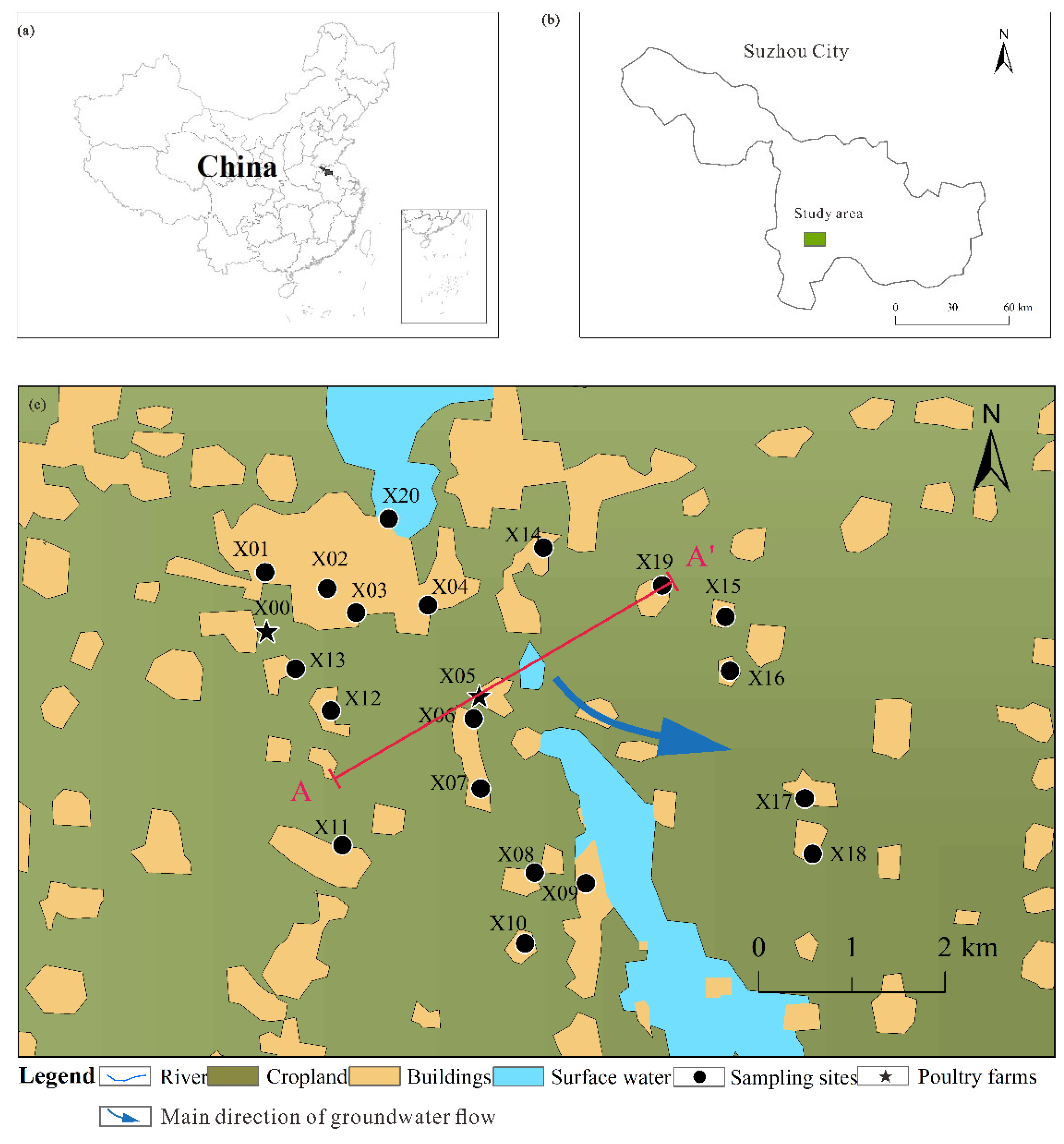
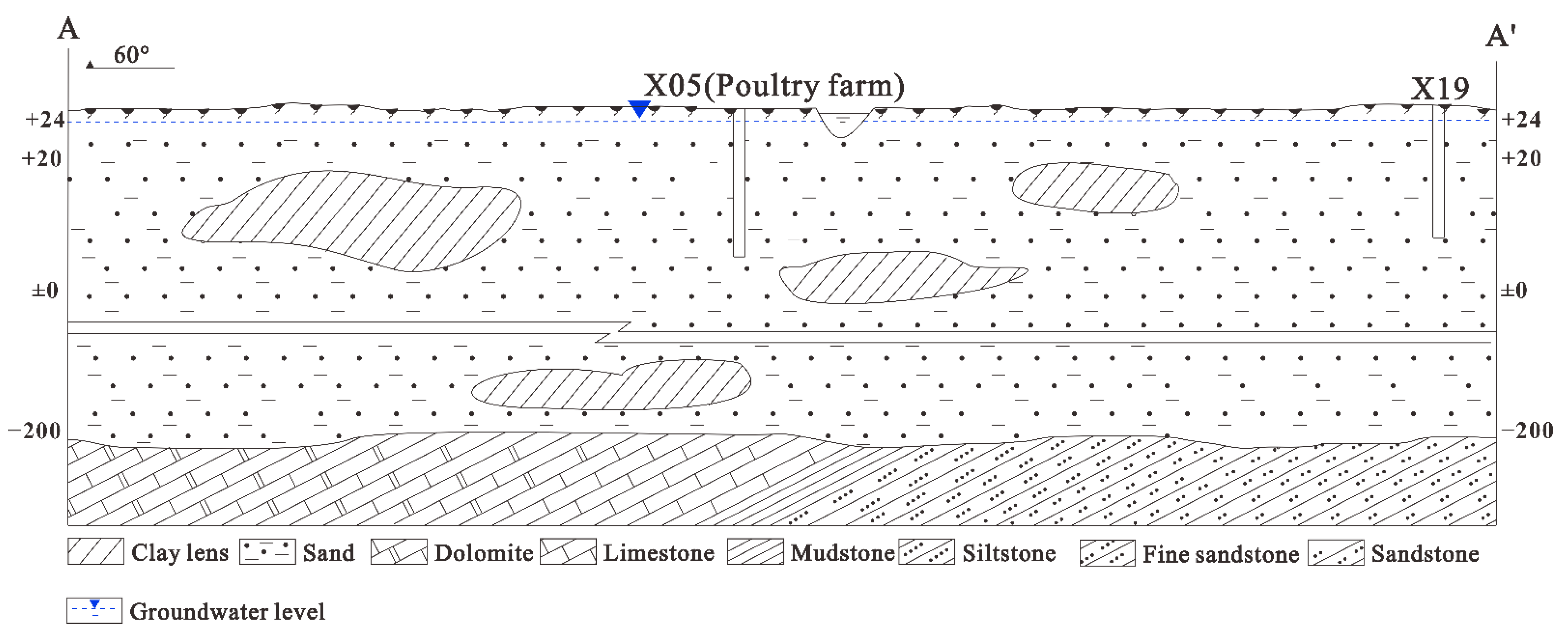
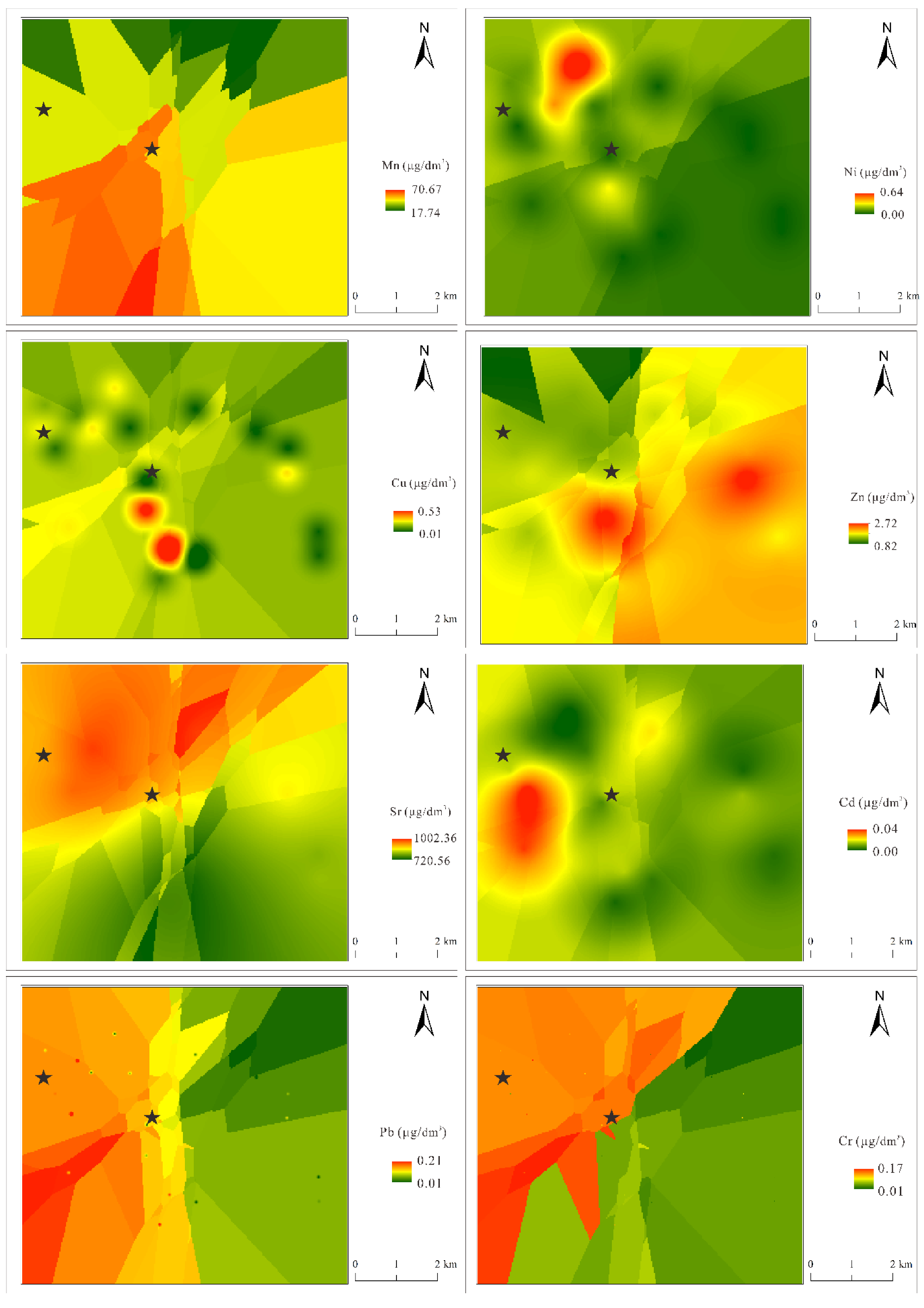
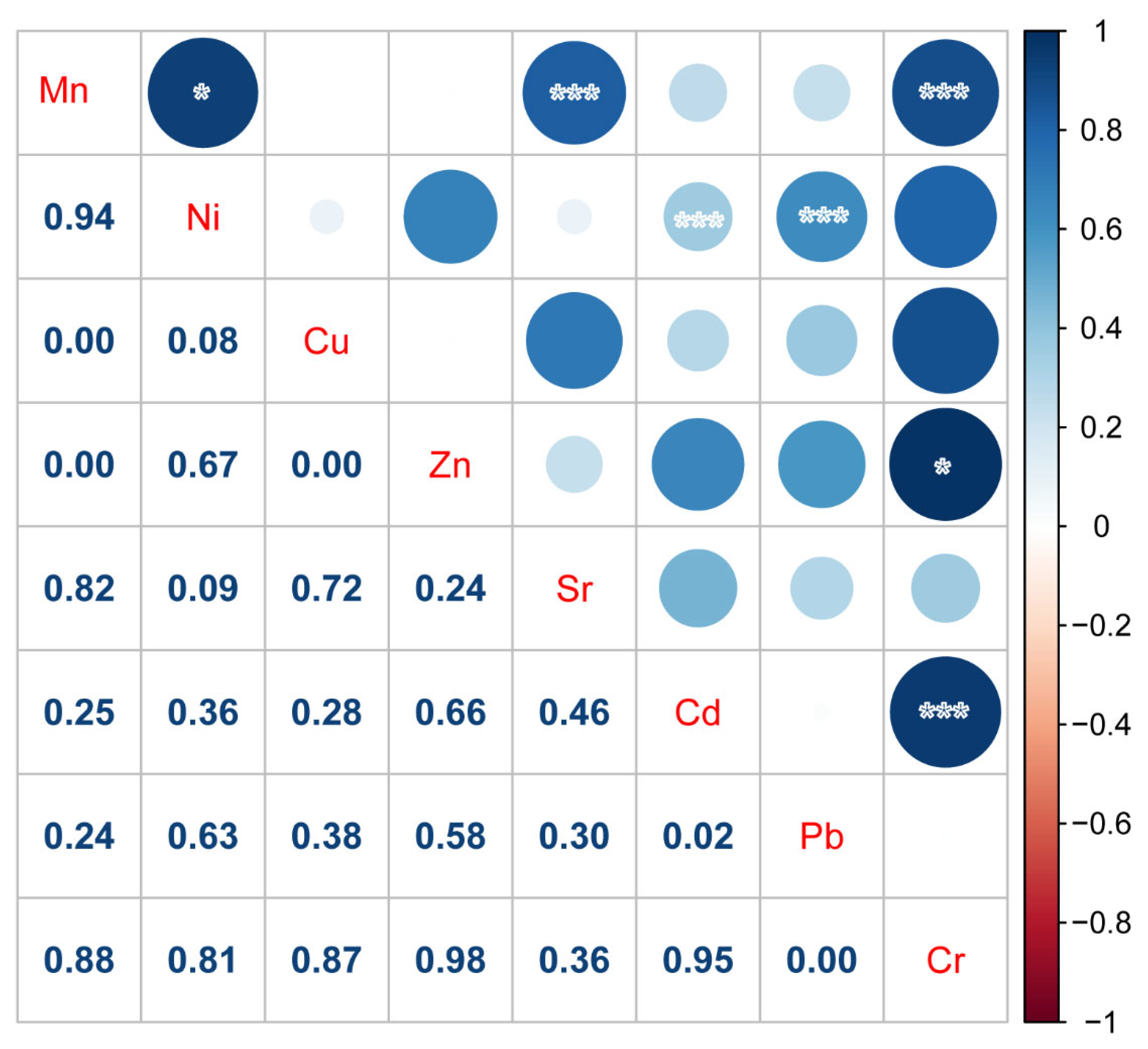

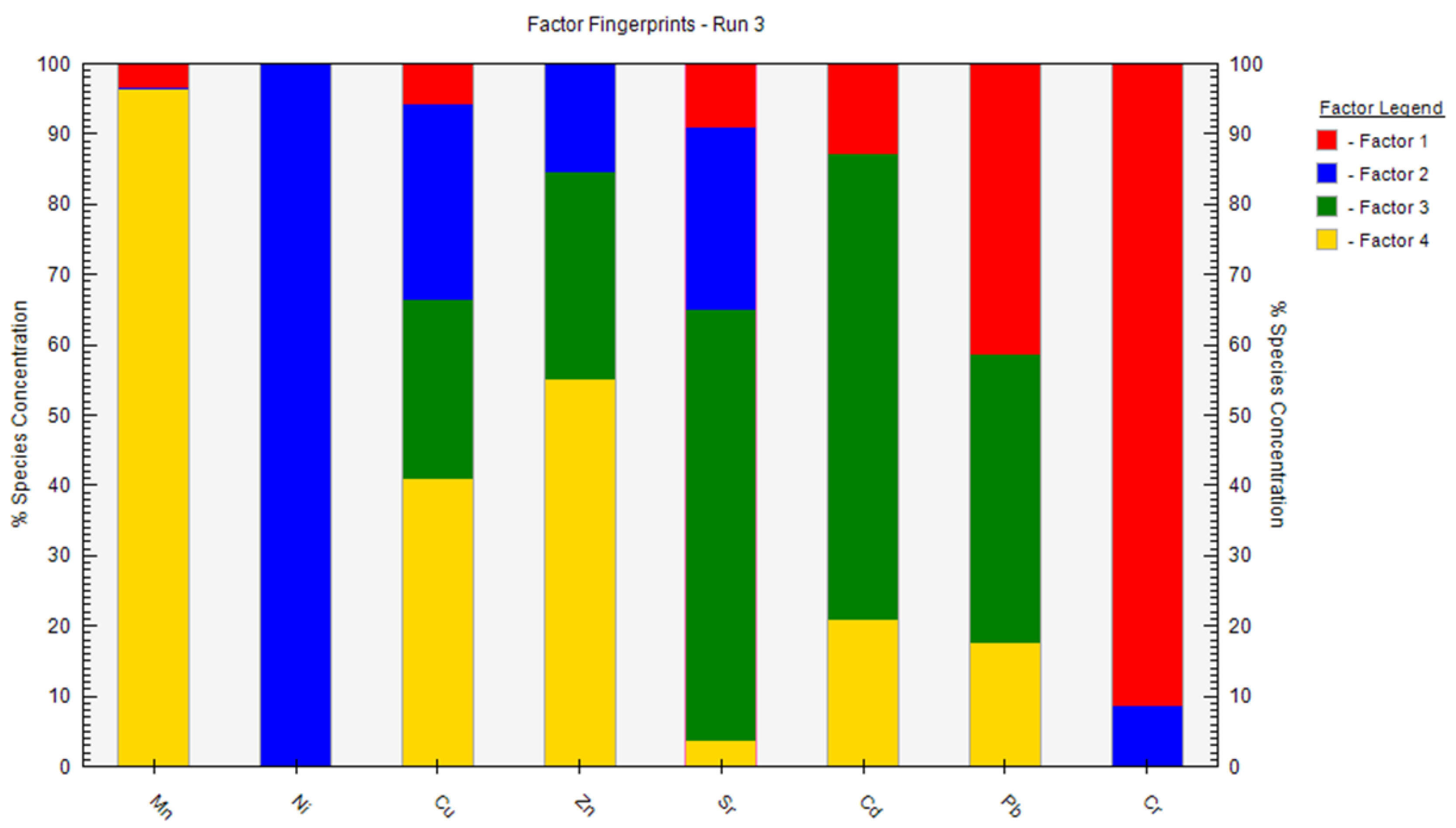
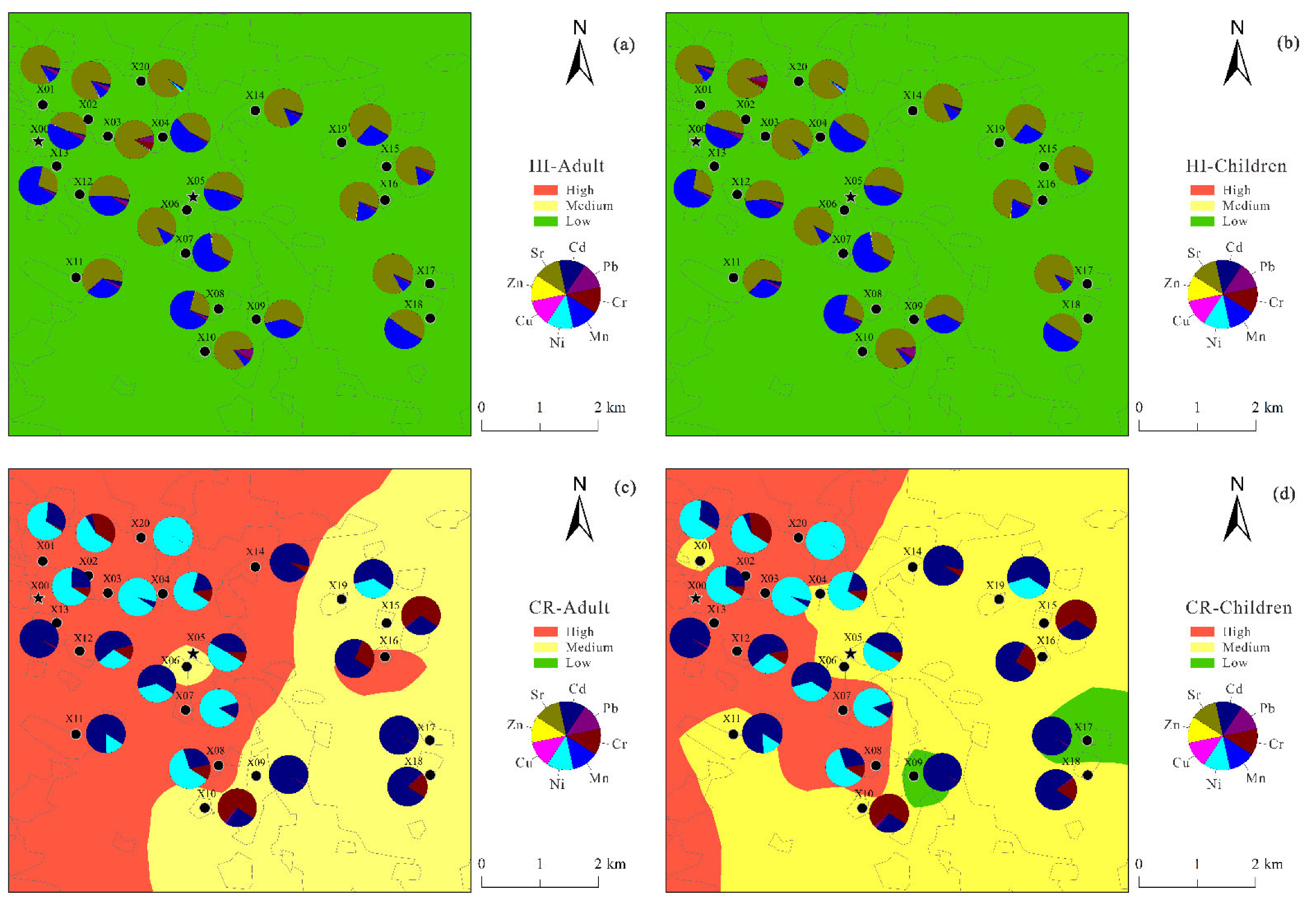
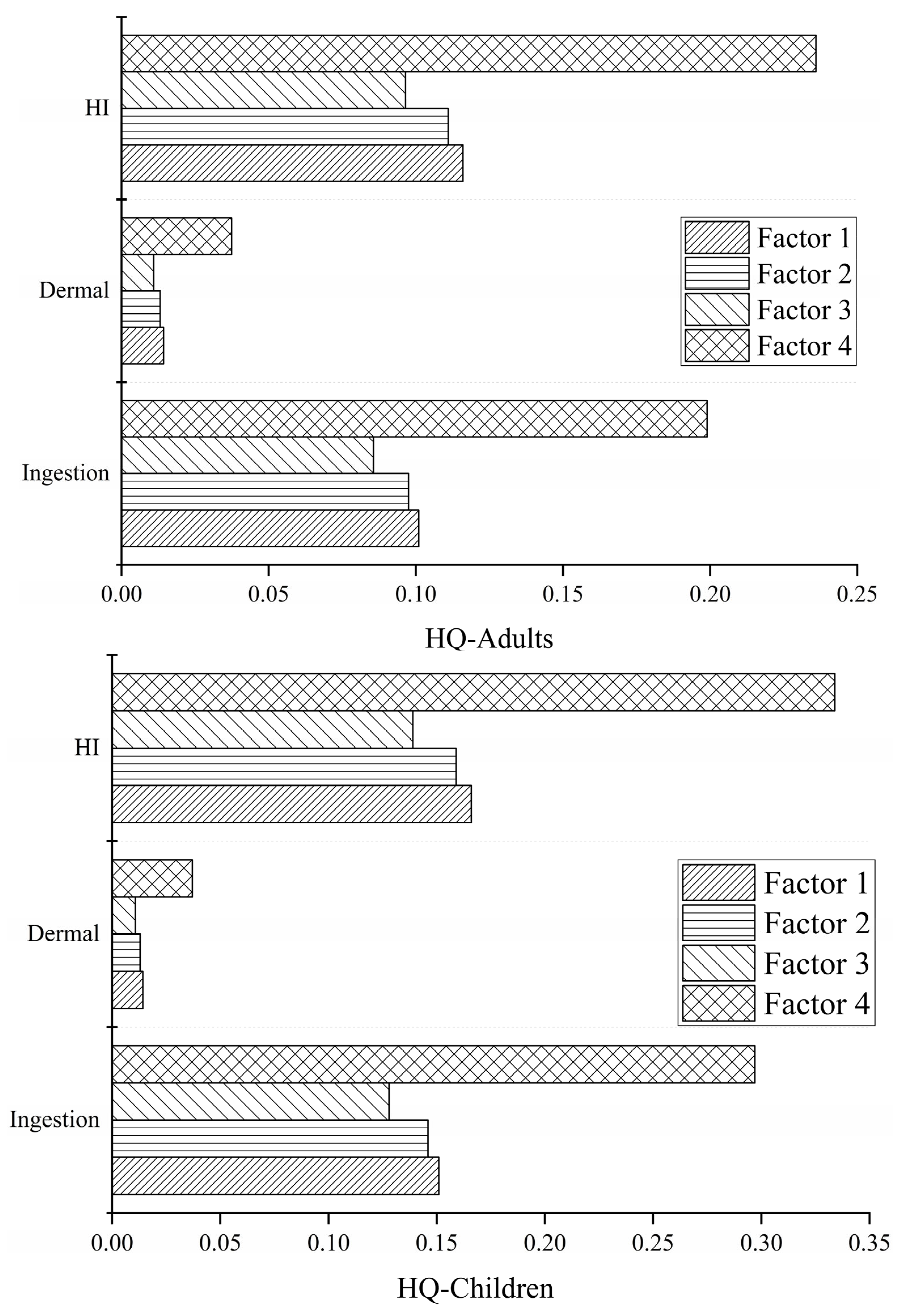

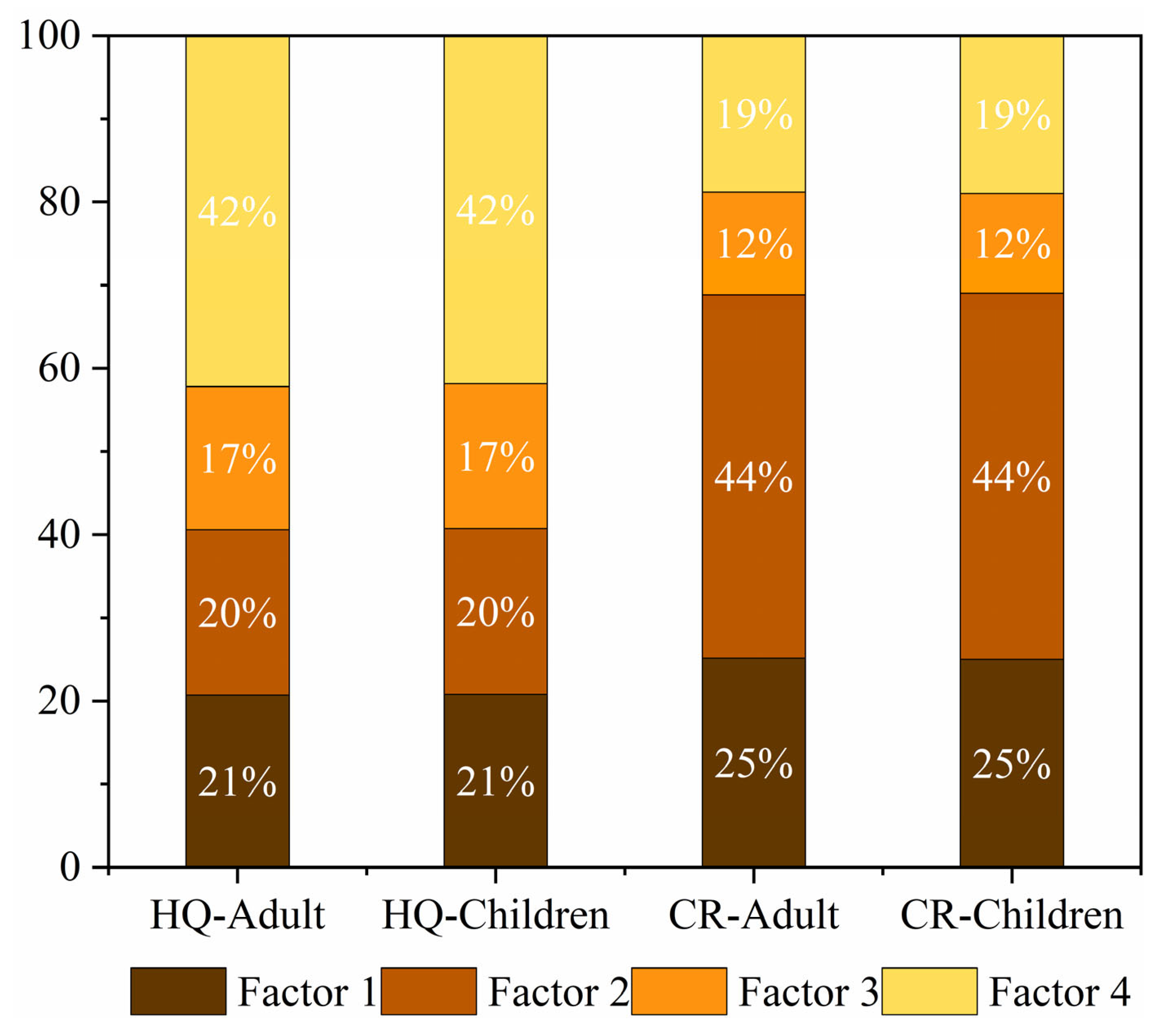
| Symbol | Parameter | Units | Distribution | |
|---|---|---|---|---|
| Adult | Child | |||
| Cw | average concentration | μg/L | ||
| IR | intake rate | L/day | 2 | 0.64 |
| EF | exposure frequency | days/year | 350 | 350 |
| ED | duration of exposure | years | 30 | 6 |
| SA | exposed area of skin | cm2 | 18,000 | 6600 |
| ET | exposure time | h/day | 1 | 0.58 |
| BW | body weight | kg | 70 | 15 |
| AT (noncarcinogenic) | average time | days | 10,950 | 2190 |
| AT (carcinogenic) | average time | days | 25,550 | 25,550 |
| RfDingestion (μg/kg/day) | RfDdermal (μg/kg/day) | Kp d (cm/h) | SFingestion (mg/kg/d)−1 | SFdermal (mg/kg/d)−1 | |
|---|---|---|---|---|---|
| Mn a | 24 | 0.96 | 1 × 10−3 | ||
| Ni a | 20 | 0.8 | 2 × 10−4 | 1.7 | 42.5 |
| Cu a | 40 | 8 | 1 × 10−3 | ||
| Zn a | 300 | 60 | 6 × 10−4 | ||
| Sr b,c | 600 | 120 | 1 × 10−3 | ||
| Cd a | 0.5 | 0.025 | 1 × 10−3 | 6.1 | 0.38 |
| Pb a | 1.4 | 0.42 | 1 × 10−4 | 8.5 × 10−3 | 0.073 |
| Cr a | 3 | 0.075 | 1 × 10−3 | 0.5 | 20 |
| Heavy Metals | Range (µg/dm3) | SD | Class a | WHO b |
|---|---|---|---|---|
| Mn | 0.03–234.19 | 69.73 | 100 | 500 |
| Ni | 0.00–0.65 | 0.16 | 20 | 20 |
| Cu | 0.01–0.55 | 0.12 | 1000 | 1000 |
| Zn | 0.29–7.26 | 1.87 | 1000 | 5000 |
| Sr | 360.09–1528.99 | 323.21 | - | - |
| Cd | 0.00–0.04 | 0.01 | 5 | 5 |
| Pb | 0.01–0.25 | 0.06 | 10 | 10 |
| Cr | 0.00–0.31 | 0.07 | 50 | 50 |
| Location | Mn | Ni | Cu | Zn | Sr | Cd | Pb | Cr | References |
|---|---|---|---|---|---|---|---|---|---|
| Western Pomerania | 160 | - | 10 | 57 | 224 | - | 37 | 5 | [45] |
| Songyuan City | - | - | - | - | 900 | - | - | - | [46] |
| Guilin City | - | - | 0.36 | 0.63 | - | 0.06 | 0.12 | - | [47] |
| India | - | 5.71 | 26.85 | 124.25 | - | 0.067 | 14.36 | >10 | [4] |
| This study | 42.82 | 0.09 | 0.18 | 1.64 | 869.66 | 0.01 | 0.07 | 0.03 | This study |
| Source | Mn | Ni | Cu | Zn | Sr | Cd | Pb | Cr | Contribution Ratios |
|---|---|---|---|---|---|---|---|---|---|
| Factor 1 | 3.30 | 0 | 5.80 | 0 | 9.00 | 13.00 | 41.40 | 91.30 | 20.48 |
| Factor 2 | 0.20 | 100 | 27.80 | 15.50 | 26.10 | 0 | 0 | 8.70 | 22.29 |
| Factor 3 | 0 | 0 | 25.50 | 29.40 | 61.30 | 66.20 | 41.10 | 0 | 27.94 |
| Factor 4 | 96.40 | 0 | 41.00 | 55.20 | 3.60 | 20.80 | 17.60 | 0 | 29.33 |
| Adult | Children | |||||
|---|---|---|---|---|---|---|
| Pathway | Ingestion | Dermal | Total | Ingestion | Dermal | Total |
| Noncarcinogenic risk (HQ) a | ||||||
| Factor 1 | 1.01 × 10−1 | 1.43 × 10−2 | 1.16 × 10−1 | 1.51 × 10−1 | 1.42 × 10−2 | 1.66 × 10−1 |
| Factor 2 | 9.75 × 10−2 | 1.31 × 10−2 | 1.11 × 10−1 | 1.46 × 10−1 | 1.30 × 10−2 | 1.59 × 10−1 |
| Factor 3 | 8.56 × 10−2 | 1.09 × 10−2 | 9.65 × 10−2 | 1.28 × 10−1 | 1.08 × 10−2 | 1.39 × 10−1 |
| Factor 4 | 1.99 × 10−1 | 3.74 × 10−2 | 2.36 × 10−1 | 2.97 × 10−1 | 3.71 × 10−2 | 3.34 × 10−1 |
| THI | 4.83 × 10−1 | 7.57 × 10−2 | 5.59 × 10−1 | 7.22 × 10−1 | 7.51 × 10−2 | 7.97 × 10−1 |
| Carcinogenic risk (CR) a | ||||||
| Factor 1 | 3.85 × 10−3 | 4.03 × 10−4 | 4.25 × 10−3 | 1.15 × 10−3 | 8.03 × 10−5 | 1.23 × 10−3 |
| Factor 2 | 6.93 × 10−3 | 3.75 × 10−4 | 7.31 × 10−3 | 2.07 × 10−3 | 7.46 × 10−5 | 2.15 × 10−3 |
| Factor 3 | 2.01 × 10−3 | 8.16 × 10−5 | 2.09 × 10−3 | 6.01 × 10−4 | 1.63 × 10−5 | 6.17 × 10−4 |
| Factor 4 | 3.03 × 10−3 | 1.41 × 10−4 | 3.18 × 10−3 | 9.06 × 10−4 | 2.81 × 10−5 | 9.35 × 10−4 |
| TCRI | 1.58 × 10−2 | 1.00 × 10−3 | 1.68 × 10−2 | 4.73 × 10−3 | 1.99 × 10−4 | 4.93 × 10−3 |
Publisher’s Note: MDPI stays neutral with regard to jurisdictional claims in published maps and institutional affiliations. |
© 2022 by the authors. Licensee MDPI, Basel, Switzerland. This article is an open access article distributed under the terms and conditions of the Creative Commons Attribution (CC BY) license (https://creativecommons.org/licenses/by/4.0/).
Share and Cite
Chen, J.; Gui, H.; Guo, Y.; Li, J. Health Risk Assessment of Heavy Metals in Shallow Groundwater of Coal–Poultry Farming Districts. Int. J. Environ. Res. Public Health 2022, 19, 12000. https://doi.org/10.3390/ijerph191912000
Chen J, Gui H, Guo Y, Li J. Health Risk Assessment of Heavy Metals in Shallow Groundwater of Coal–Poultry Farming Districts. International Journal of Environmental Research and Public Health. 2022; 19(19):12000. https://doi.org/10.3390/ijerph191912000
Chicago/Turabian StyleChen, Jiayu, Herong Gui, Yan Guo, and Jun Li. 2022. "Health Risk Assessment of Heavy Metals in Shallow Groundwater of Coal–Poultry Farming Districts" International Journal of Environmental Research and Public Health 19, no. 19: 12000. https://doi.org/10.3390/ijerph191912000
APA StyleChen, J., Gui, H., Guo, Y., & Li, J. (2022). Health Risk Assessment of Heavy Metals in Shallow Groundwater of Coal–Poultry Farming Districts. International Journal of Environmental Research and Public Health, 19(19), 12000. https://doi.org/10.3390/ijerph191912000






